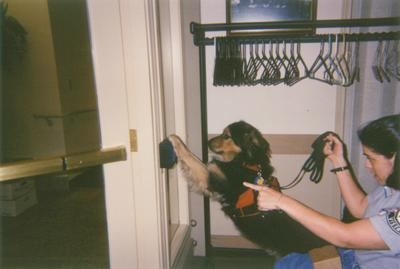 | ||
In general, an assistance dog is trained to aid or assist an individual with a disability. Many are trained by an assistance dog organization, or by their handler, often with the help of a professional trainer.
Contents
Classification
Assistance dogs fall into two broad categories: service dogs and facility dogs. Service dogs are defined by the Americans with Disabilities Act as dogs that are individually trained to do work or perform tasks for people with disabilities. State and local governments, businesses, and nonprofit organizations that serve the public generally must allow service animals to accompany people with disabilities in all areas of the facility where the public is normally allowed to go. Facility dogs are used by working professionals to aid multiple people.
Common examples of service dogs include:
Common examples of facility dogs include:
In the United States, the term service dog may be used synonymously with assistance dog.
Similarities and differences between facility dogs and therapy dogs
Because both may aid people in similar settings such as healthcare environments, facility dogs are often mistakenly called therapy dogs; however, there are several important distinctions between them. Facility dogs are trained by accredited assistance dog organizations and therapy dogs are trained by their owners. Facility dogs may be handled by a wide variety of working professionals, while therapy dogs must be handled by their owners.
Facility dogs are trained by canine professionals for a period of 18 to 24 months, and must pass very rigorous tests before graduating from an assistance dog organization. In contrast, registration for therapy dogs by a therapy dog organization does not require enrollment in obedience classes or therapy dog classes, meaning that therapy dogs often undergo a much less rigorous training process. Furthermore, the tests that therapy dogs must pass are less complicated and challenging than those taken by facility dogs.
A person with either a therapy dog or a facility dog must have permission from the facilities they visit before they can enter with their animal. They do not have the right to demand access to places where pets are not generally permitted, or to have fees associated with their pets waived.
